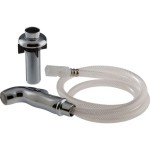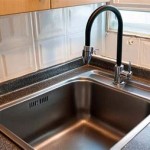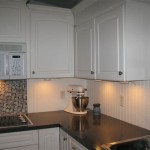White Tiles For Kitchen Walls: A Comprehensive Guide
White tiles have consistently remained a popular choice for kitchen walls, transcending fleeting trends to become a timeless staple in interior design. Their versatility, clean aesthetic, and practical benefits contribute to their enduring appeal among homeowners and designers alike. This article delves into the myriad aspects of using white tiles for kitchen walls, exploring the various tile types, styles, design considerations, and maintenance requirements to provide a comprehensive understanding of this classic design element.
The selection of white tiles for kitchen walls is a decision that impacts both the functionality and aesthetic of the space. Factors such as the size of the kitchen, the amount of natural light available, the overall design style, and the homeowner's personal preferences all play a crucial role in determining the most suitable type of white tile. Choosing the right tile not only enhances the visual appeal of the kitchen but also ensures its long-term durability and ease of maintenance.
Understanding the Appeal of White Tiles
The enduring popularity of white tiles for kitchen walls stems from several key attributes. Firstly, white is a neutral color that complements a wide range of design styles, from traditional to contemporary. This adaptability allows homeowners to seamlessly integrate white tiles into existing kitchen layouts or incorporate them into new constructions without clashing with other design elements.
Secondly, white tiles contribute significantly to the brightness and airiness of a kitchen. They reflect light, making the space feel larger and more open. This is particularly beneficial in kitchens with limited natural light or smaller dimensions. The reflective quality of white tiles can also enhance the visibility of work surfaces, improving safety and efficiency during food preparation.
Thirdly, white is often associated with cleanliness and hygiene, making it an ideal choice for a kitchen environment. The bright, clean appearance of white tiles can instill a sense of order and freshness, which is particularly important in a space where food is prepared and consumed.
Exploring Different Types of White Tiles
The market offers a diverse array of white tiles suitable for kitchen walls, each with its unique characteristics, advantages, and disadvantages. Among the most common types are ceramic, porcelain, glass, and natural stone tiles. Understanding the properties of each tile type is essential for making an informed decision that aligns with specific needs and preferences.
Ceramic tiles are a cost-effective and versatile option. They are relatively easy to install and come in a wide range of shapes, sizes, and textures. Ceramic tiles are generally durable and water-resistant, making them suitable for kitchen walls that are not subjected to heavy water exposure. However, they are more porous than porcelain tiles and may be more prone to staining if not properly sealed.
Porcelain tiles are a denser and more durable option than ceramic tiles. They are highly resistant to water, stains, and scratches, making them an excellent choice for kitchen walls that require high levels of protection. Porcelain tiles are also available in a wide variety of designs, including those that mimic the look of natural stone or wood. Their durability and resistance to wear and tear make them a long-lasting investment.
Glass tiles offer a sleek and modern aesthetic. They are non-porous and easy to clean, making them a hygienic option for kitchen walls. Glass tiles are also available in a variety of colors, shapes, and sizes, allowing for creative and personalized designs. However, glass tiles can be more expensive than ceramic or porcelain tiles and may require professional installation.
Natural stone tiles, such as marble, granite, and travertine, offer a luxurious and timeless look. They are durable and add a touch of elegance to any kitchen. However, natural stone tiles are often more expensive and require more maintenance than other tile types. They are also more porous and may require sealing to prevent staining.
Design Considerations for White Tile Kitchen Walls
The design of white tile kitchen walls involves careful consideration of several factors, including tile size, shape, layout, grout color, and overall kitchen style. These elements work together to create a cohesive and visually appealing space.
Tile size and shape can significantly impact the overall look of the kitchen. Larger tiles tend to create a more modern and seamless appearance, while smaller tiles can add texture and visual interest. Subway tiles, with their classic rectangular shape, are a popular choice for kitchen walls, while square tiles offer a more traditional look. Other shapes, such as hexagonal or mosaic tiles, can be used to create unique and eye-catching designs.
The layout of the tiles is another important design consideration. A simple grid pattern is a classic and versatile choice, while more complex patterns, such as herringbone or brick patterns, can add visual interest. The layout should complement the overall style of the kitchen and enhance the desired aesthetic.
Grout color plays a crucial role in defining the look of the tiled surface. White grout can create a seamless and minimalist appearance, while darker grout can accentuate the shape and pattern of the tiles. The choice of grout color should also consider the practical aspect of maintenance, as darker grout is less likely to show stains than lighter grout.
The overall kitchen style should guide the selection of white tiles. In a modern kitchen, sleek and minimalist white tiles with a glossy finish may be appropriate. In a traditional kitchen, textured white tiles with a matte finish may be a better fit. The tiles should complement the other design elements in the kitchen, such as cabinets, countertops, and appliances.
Furthermore, consider the backsplash area. The backsplash area, the area of the wall behind the countertops and sink, is one of the most important areas to consider when choosing white tiles for kitchen walls. Properly applying tiles to this area is crucial for protecting the wall from moisture, grease, and stains. It also provides an opportunity to add a decorative element to the kitchen. The height of the backsplash should be carefully considered to ensure adequate protection and visual appeal. Typically, a backsplash extends from the countertop to the bottom of the upper cabinets.
Maintaining White Tile Kitchen Walls
Maintaining white tile kitchen walls is essential for preserving their appearance and functionality over time. Regular cleaning and proper sealing can prevent staining, water damage, and other issues.
Regular cleaning involves wiping down the tiles with a damp cloth or sponge after each use to remove spills, splatters, and grease. For tougher stains, a mild detergent or tile cleaner can be used. Avoid using abrasive cleaners or harsh chemicals, as they can damage the surface of the tiles.
Grout is particularly susceptible to staining and discoloration. To prevent this, seal the grout after installation and re-seal it periodically as needed. Grout sealers create a barrier that prevents liquids and stains from penetrating the grout. Regular cleaning with a grout brush and a mild cleaner can also help keep the grout clean and bright.
Proper ventilation in the kitchen can help prevent moisture buildup, which can lead to mold and mildew growth on the tiles and grout. Ensure that the kitchen is well-ventilated, especially during cooking and cleaning. Using a range hood or opening windows can help improve ventilation.
In areas prone to water exposure, such as around the sink, consider using a sealant to protect the tiles and grout from water damage. Re-apply the sealant as needed to maintain its effectiveness.
The selection and application of white tiles for kitchen walls is a process that requires careful planning and attention to detail. The long-term benefits of white tiles, however, make the effort worthwhile. With proper selection, installation, and maintenance, white tile kitchen walls can provide a durable, stylish, and hygienic surface that enhances the overall appeal of the kitchen for years to come.

185 Best White Kitchen Wall Tile Interior Design Ideas Images 2025

Kitchen Wall Tile Modern Classic Designs The Shop

White Kitkat Kitchen Tiles Design Ideas With Images In 2025

Kitchen Wall Tile Modern Classic Designs The Shop

White Wall Tiles Direct Tile Warehouse

4 Classic White Color Tiles Wall Floor Designs Hanseceramictile

Buy Kitchen Wall Tiles Cheap Online

Solana White Flat Matt Wall Tile Tiles Mosaics

300 600mm Foshan Pure White Glossy Ceramic Kitchen Wall Tile Tiles Made In Com

185 Best White Kitchen Wall Tile Interior Design Ideas Images 2025








